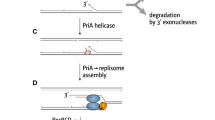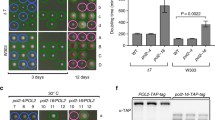Summary
The REV2 gene controls DNA repair, induced mutagenesis and, probably, some fidelity mechanism of replication. Of particular interest is the notion that it is inducible by DNA-damaging agents. We wanted to find molecular evidence for these results derived from numerous biological experiments. We cloned the REV2 gene from a yeast genomic DNA library based on the YCp 50 centromere vector, sequenced it and studied its regulation on the transcriptional level. The coding region of the REV2 gene consists of a 1425 pb reading frame with a coding capacity for a polypeptide of 52 kD; no significant homology to any gene filed in available data bases was found. Examination of a hydrophobicity plot of the putative Rev2 protein predicts the existence of transmembrane helices. Quantitative Northern analysis confirmed the working hypothesis that DNA-damaging agents increase the level of REV2 gene expression in stationary cells. Thus, the REV2 gene seems to code for a membrane protein which is inducible by DNA-damaging agents and which controls processes of repair and mutagenesis in yeast.
Similar content being viewed by others
References
Büscher M, Rahmsdorf HJ, Litfin M, Karin M, Herrlich P (1988) Activation of the c-fos gene by UV and phorbol ester: different signal transduction pathways converge to the same enhancer element. Oncogene 3:301–311
Cole GM, Schild D, Lovett ST, Mortimer RK (1987) Regulation of RAD 54- and RAD 52-lacZ gene fusions inSaccharomyces cerevisiae in response to DNA damage. Mol Cell Biol 7:1078–1084
Cole GM, Schild D, Mortimer RK (1989) Two DNA repair and recombination genes inSaccharomyces cerevisiae, RAD 52 and RAD 54, are induced during meiosis. Mol Cell Biol 9:3101–3104
Eckardt-Schupp F, Ahne F, Geigl EM, Siede W (1988) Is mismatch repair involved in UV-induced mutagenesis inSaccharomyces cerevisiae? In: Moses RE, Summers WC (eds) DNA replication and mutagenesis. American Society for Microbiology, Washington, DC, pp 355–361
Eckardt-Schupp F, Ahne F, Obermaier S, Wendel S (1990) UV-inducible repair in yeast. In: Riklis E (ed) Photobiology: the science and its applications. Plenum Press, New York
Fleer R, Nicolet CM, Pure GA, Friedberg EC (1987a) RAD 4 gene ofSaccharomyces cerevisiae: molecular cloning and partial characterization of a gene that is inactivated inEscherichia coli. Mol Cell Biol 7:1180–1192
Fleer R, Siede W, Friedberg EC (1987b) Mutational inactivation ofSaccharomyces cerevisiae RAD 4 gene inEscherichia coli. J Bacteriol 169:4884–4892
Friedberg EC (1988) Deoxyribonucleic acid repair in the yeastSaccharomyces cerevisiae. Microbiol Rev 52:70–102
Friedberg EC, Siede W, Cooper AJ (1990) Cellular responses to DNA damage in yeast. In: Jones A, Pringle JR, Broach J (eds) The molecular biology of the yeastSaccharomyces. Cold Spring Harbor, New York (in press)
Haynes RH, Kunz BA (1981) DNA repair and mutagenesis in yeast. In: Strathern JN, Jones EW, Broach JR (eds) The molecular biology of the yeastSaccharomyces cerevisiae: Life cycle and inheritance. Cold Spring Harbor, New York, pp 371–414
Haynes RH, Eckardt F, Kunz BA (1985) Analysis of non-linearities in mutation frequency curves. Mutat Res 15:51–59
Jentsch S, McGrath JP, Varshavsky A (1987) The yeast DNA repair gene RAD6 encodes a ubiquitin-conjugating enzyme. Nature 329:131–134
Johnston LH, Nasmyth KA (1978)Saccharomyces cerevisiae cell cycle cdc9 is defective in DNA ligase. Nature 274:891–893
Kaina B, Stein B, Schönthal A, Rahmsdorf HJ, Ponta H, Herrlich P (1989) An update of the mammalian UV-response: gene regulation and induction of a protective function. In: Lambert MW, Laval J (eds) DNA repair mechanisms and their biological implications in mammalian cells. Plenum Press, New York, pp 149–165
Karin M, Herrlich P (1988) Cis- and trans-acting genetic elements responsible for induction of specific genes by tumor promotors, serum factors and stress. In: Colburn NH (ed) Genes and signal transduction in multistage carcinogenesis. Dekker, New York, pp 415–440
Kuo CL, Campbell JK (1983) Cloning ofSaccharomyces cerevisiae replication genes: isolation of the CDC8 gene and two genes that compensate for the cdc8 mutation. Mol Cell Biol 3:1730–1737
Lawrence CW (1982) Mutagenesis inSaccharomyces cerevisiae. Adv Genet 21:173–254
Lawrence CW, Christensen R (1978) Ultraviolet-induced reversion of cyc 1 alleles in radiation sensitive strains of yeast. II. rev2 mutant strains. Genetics 90:213–226
Lemontt JF (1971) Mutants of yeast defective in mutations induced by ultraviolet light. Genetics 68:21–33
Madura K, Prakash S, Prakash L (1990) Expression of theSaccharomyces cerevisiae repair gene RAD6 that encodes a ubiquitin conjugating enzyme, increases in response to DNA damage and in meiosis but remains constant during the mitotic cell cycle. Nucl Acids Res 18:771–778
Mortimer RK, Schild D (1985) Genetic map ofSaccharomyces cerevisia, ed 9. Microbiol Rev 49:181–212
Naumovski L, Friedberg EC (1988) Rad3 protein ofSaccharomyces cerevisiae: overexpression and preliminary characterization using specific antibodies. Mol Gen Genet 209:458–466
Protic M, Roilides E, Levine AS, Dixon K (1988) Enhancement of DNA repair capacity of mammalian cells by carcinogen treatment. Somat Cell Mol Genet 14:351
Schild D, Johnston J, Chang C, Mortimer RK (1984) Cloning and mapping ofSaccharomyces cerevisiae photoreactivation gene PHR 1. Mol Cell Biol 4:1864–1870
Siede W, Brendel M (1981) Isolation and characterization of yeast mutants with thermoconditional sensitivity to the bifunctional alkylating agent nitrogen mustard. Curr Genet 4:145–149
Siede W, Eckardt F (1984) Inducibility of error-prone DNA repair in yeast. Mutat Res 129:3–11
Siede W, Eckardt F (1986a) Analysis of mutagenic DNA repair in a thermoconditional mutant ofSaccharomyces cerevisiae. III. Dose-response pattern of mutation induction in UV-irradiated rev2ts cells. Mol Gen Genet 202:68–74
Siede W, Eckardt F (1986b) Analysis of mutagenic DNA repair in a thermoconditional mutant ofSaccharomyces cerevisiae. IV. Influence of DNA replication and excision repair on rev2ts dependent UV-mutagenesis and repair. Curr Genet 10:871–878
Siede W, Eckardt-Schupp F (1986a) A mismatch repair-based model can explain some features of UV mutagenesis in yeast. Mutagenesis 1:471–474
Siede W, Eckardt-Schupp F (1986b) DNA repair genes ofSaccharomyces cerevisiae: complementing rad4 and rev2ts mutations by plasmids which cannot be propagated inEscherichia coli. Curr Genet 11:205–210
Siede W, Eckardt F, Brendel M (1983a) Analysis of mutagenic DNA repair in a thermoconditional mutant ofSaccharomyces cerevisiae. I. Influence of cycloheximide of UV irradiated stationary phase rev2ts cells. Mol Gen Genet 190:406–412
Siede W, Eckardt F, Brendel M (1983b) Analysis of mutagenic DNA repair in a thermoconditional mutant ofSaccharomyces cerevisiae. II. Influence of cycloheximide on UV-irradiated exponentially growing phase rev2st cells. Mol Gen Genet 190:413–416
Siede W, Robinson GW, Kalainov D, Malley T, Friedberg EC (1989) Regulation of the RAD2 gene ofSaccharomyces cerevisiae. Mol Microbiol 3:1697
Sung P, Prakash L, Weber S, Prakash S (1987) The RAD3 gene ofSaccharomyces cerevisiae encodes a DNA-dependent ATPase. Proc Natl Acad Sci USA 84:6045–6049
Sung P, Prakash L, Matson SW, Prakash S (1988) RAD3 protein ofSaccharomyces cerevisiae is a DNA helicase. Proc Natl Acad Sci USA 84:8951–8955
Author information
Authors and Affiliations
Additional information
Paper given at the workshop “Molecular Radiation Biology”. German Section of the DNA Repair Network. München-Neuherberg, 21.–23.3.1990
Rights and permissions
About this article
Cite this article
Ahne, F., Wendel, S. & Eckardt-Schupp, F. Molecular analysis of the REV 2 gene ofSaccharomyces cerevisiae - a review. Radiat Environ Biophys 29, 293–301 (1990). https://doi.org/10.1007/BF01210409
Received:
Accepted:
Issue Date:
DOI: https://doi.org/10.1007/BF01210409




